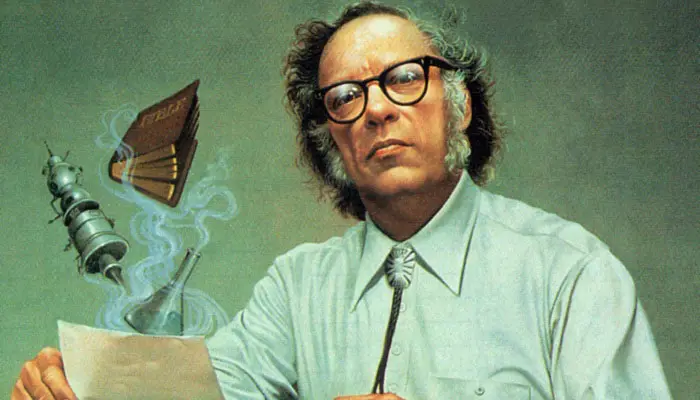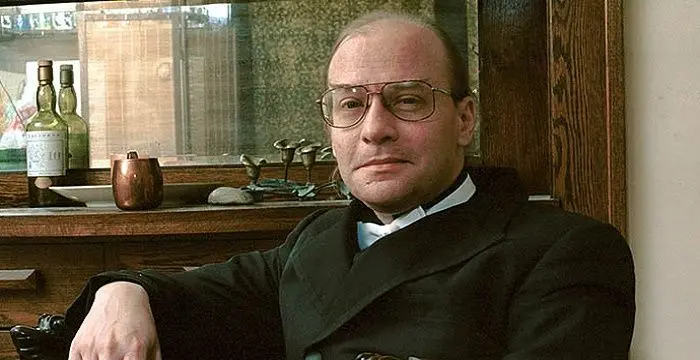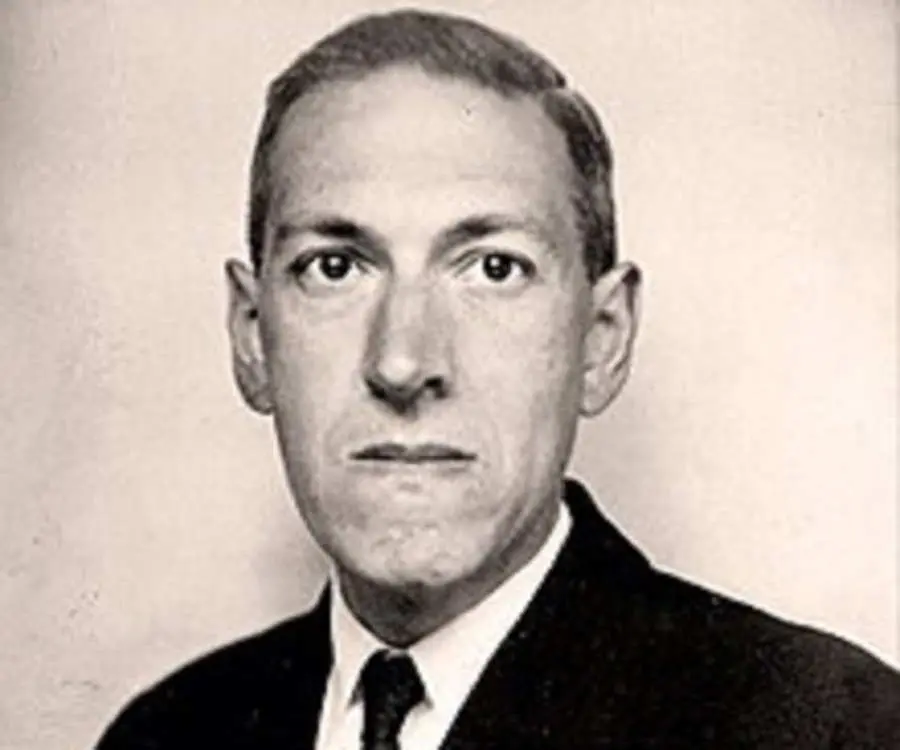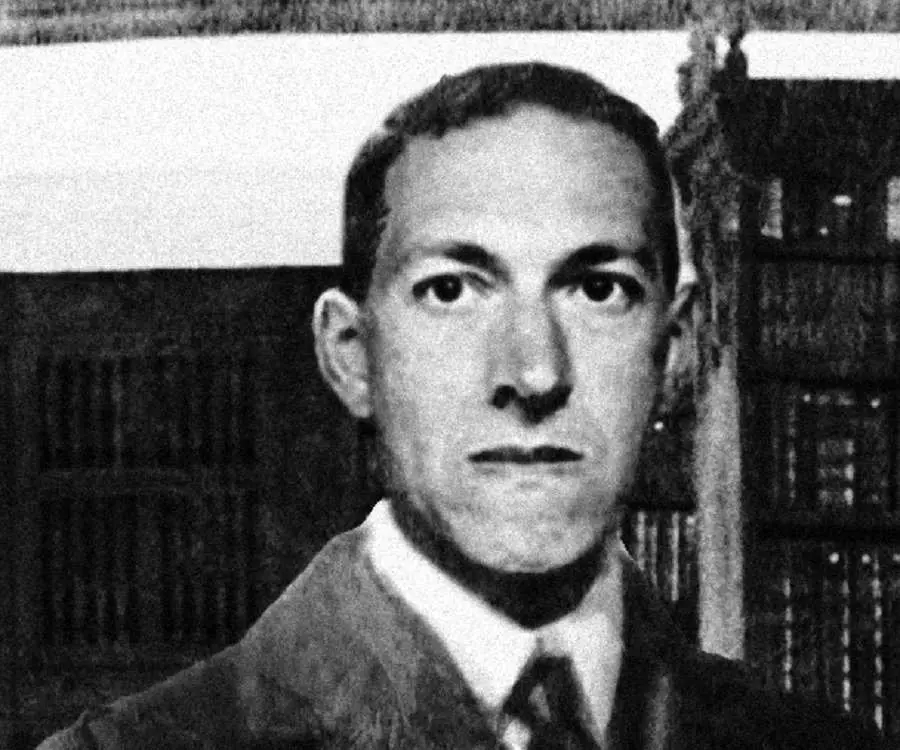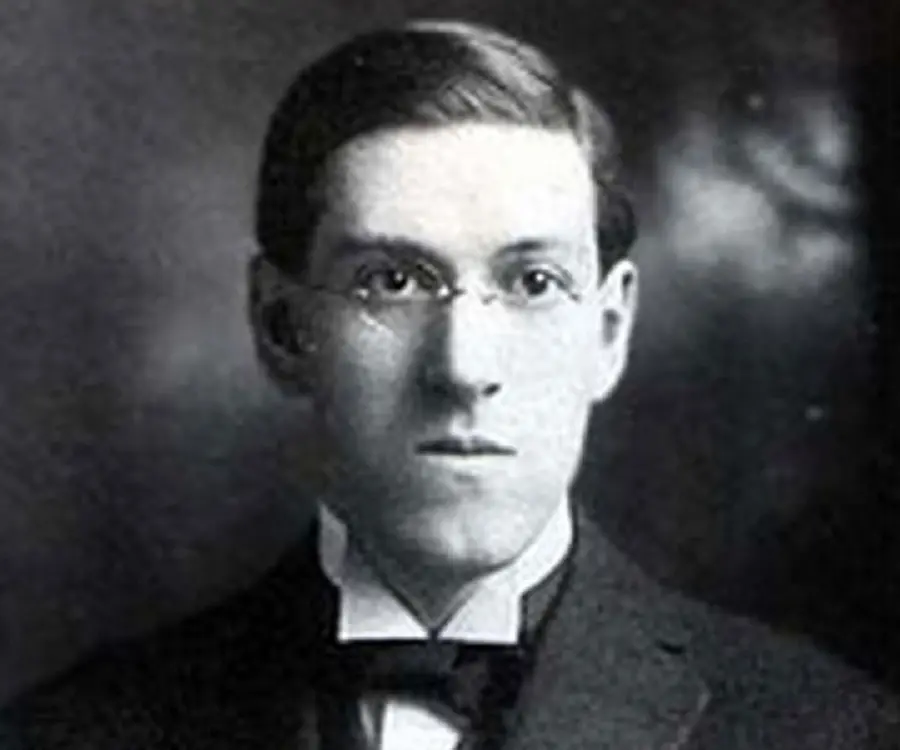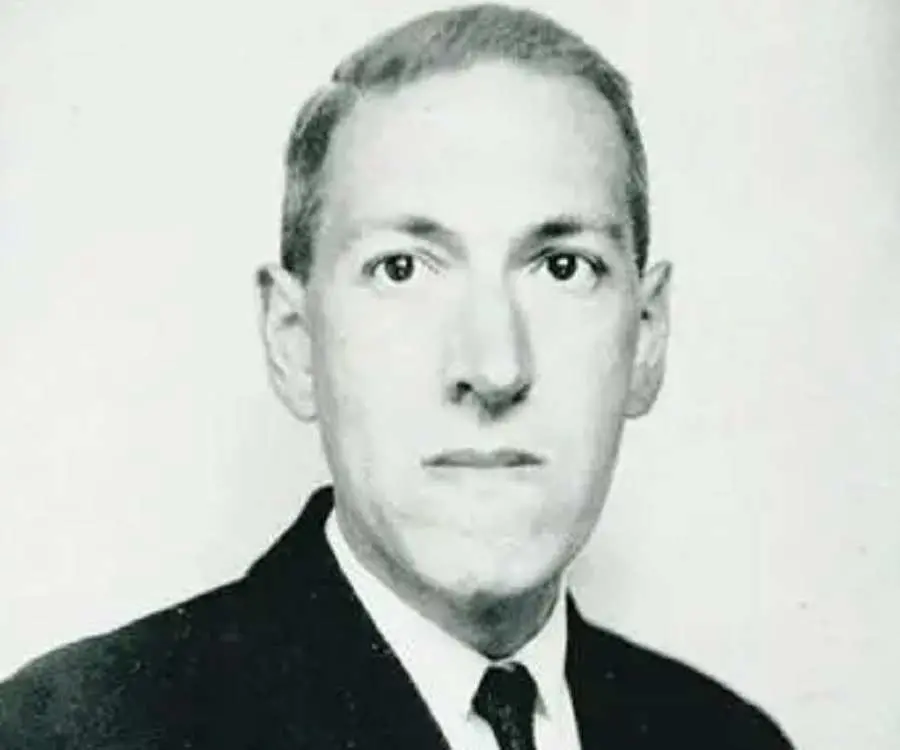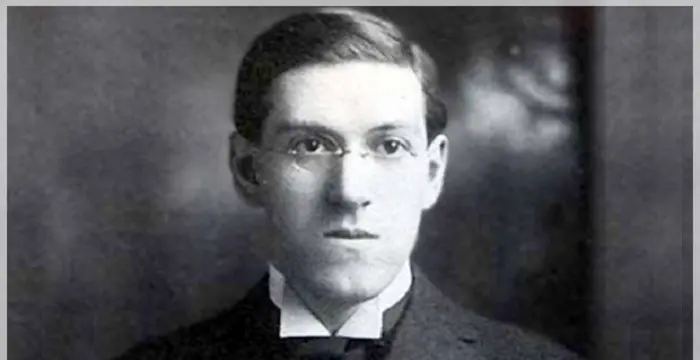
H. P. Lovecraft - Writers, Timeline and Life
H. P. Lovecraft's Personal Details
H
| Information | Detail |
|---|---|
| Birthday | August 20, 1890 |
| Died on | March 15, 1937 |
| Nationality | American |
| Famous | Atheists, Writers, Science Fiction Writers |
| City/State | Rhode Island |
| Spouses | Sonia Haft Greene |
| Known as | Howard Phillips Lovecraft |
| Universities |
|
| Cause of death |
|
| Birth Place | Providence, Rhode Island, United States |
| Religion | Atheist |
| Height | 180 |
| Gender | Male |
| Father | Winfield Scott Lovecraft |
| Mother | Sarah Susan Phillips |
| Sun Sign | Leo |
| Born in | Providence, Rhode Island, United States |
| Famous as | Writer |
| Died at Age | 46 |
// Famous Science Fiction Writers
Isaac Asimov
Isaac Asimov was an American professor of biochemistry and a renowned author of science fiction and popular science books. Read this biography to know more about his life.
Douglas Adams
Douglas Adams was an English writer best known for the science fiction series ‘The Hitchhiker's Guide to the Galaxy’. This biography of Douglas Adams provides detailed information about his childhood, life, achievements, works & timeline.
John M. Ford
John M. Ford was a renowned American writer, poet and game designer. This biography offers detailed information about his childhood, life, career, works, achievements and timeline.
H. P. Lovecraft's photo
Who is H. P. Lovecraft?
H. P. Lovecraft was an American horror fiction writer, credited with starting a trend in fantasy and science fiction (sci-fi) writing. Mostly an autodidact, he never finished school, staying at home due to fragile health, gobbling up books far advanced for his age. Writing his first story at the age of six, he took up writing as his profession at the age of twenty-four. Too shy to promote himself, he got little remuneration for his talent and most of his works were published in pulp magazines. All his life, he lived in poverty, often being forced to take up ghost-writing to meet his expenses, yet going hungry, eating bread that had gone past its expiry date. It was only after his death that two of his friends, August Derleth and Donald Wandrei, collected his stories and made arrangement for their publications. But for them, the world could have lost great pieces of treasure that has now created its own place in the canon of world literature. Lovecraft’s writings have had a great impact on modern popular cultures and have also influenced and inspired many of his contemporaries, such as August Derleth, Robert E. Howard, Robert Bloch, Fritz Leiber, Clive Barker, Stephen King, Alan Moore, Neil Gaiman and Mike Mignola.
// Famous Atheists
Morgan Freeman
Morgan Freeman is an Academy Award winning actor known for his work in movies like ‘Street Smart’, ‘Driving Miss Daisy’ and ‘Million Dollar Baby’. This biography provides detailed information about his childhood, life, achievements, works & timeline.
Robert Smith
Robert Smith is an English musician and the lead singer of the British rock band, ‘The Cure.’ This biography of Robert Smith gives detailed information on his profile, childhood, life and timeline.
Jack Black
Jack Black is a renowned American actor-producer and voice artist. Explore this biography to learn more about his profile, childhood, career and timeline
Childhood & Early Life
Howard Phillips Lovecraft was born on August 20, 1890 in Providence, Rhode Island. His father, Winfield Scott Lovecraft, a traveling salesman of jewelry and precious metal, worked for Gorham & Co. Her mother, Sarah Susan nee Phillips, was the daughter of Whipple Van Buren Phillips, a noted businessman.
In 1893, when Howard was three years old, his father went to Chicago and there in a hotel room, he suffered a nervous breakdown, possibly from untreated syphilis. Subsequently, he was placed in Butler Hospital, a psychiatric and substance-abuse hospital in Providence, where he lived until his death in 1898.
Howard was his parents’ only child. After his father was hospitalized, he moved with his mother into his maternal grandfather’s family home. Here, he lived with his mother, grandparents and his two aunts, Lillian Delora Phillips and Annie Emeline Phillips.
His maternal grandfather, Whipple Phillips, has had great influence on young Howard and instilled in him a great appreciation of classical literature and poetry. He encouraged his reading, supplying him with classics and also telling him off-the-cuff horror stories in the Gothic mode, thus stirring his interest in the weird.
Born a prodigy, Howard is said to have started reciting whole poetries by the age of two and reading by the age of three. By five, he had completed ‘The Arabian Night’ and took up the pseudonym of ‘Abdul Alhazred’.
At six, he discovered Greek mythology and began to read books like ‘Age of Fable’ by Thomas Bulfinch and children’s versions of the Iliad and Odyssey. Possibly in the same year, he wrote his first story, ‘The Noble Eavesdropper’. Unfortunately, it has since been lost.
Also at the age of six, he lost his maternal grandmother. Thereafter, he started having vivid nightmares, which must have affected his health and interfered with his formal education. Although he was enrolled at Slater Avenue School, he barely attended school until the age of eight.
Continuing to study at home, Howard wrote his first poem, ‘The Poem of Ulysses’ in 1897. It was an internally rhyming verse 88 lines long, based on Homer’s Odyssey. It is his earliest surviving work.
In 1898, at the age of eight, he was introduced to chemistry and astronomy, shortly becoming engrossed in the latter, dreaming to become an astronaut when he grew up. It was also the time, when he started growing a fondness for the writings of Edgar Allen Poe.
In 1899, plagued by various ailments like headache, nervousness and general fatigue, he had to leave school. In the same year, he produced ‘The Scientific Gazette’, a hectographed journal, which he distributed among his friends.
Around 1903, after studying at home for four years, Howard returned to school, getting admission into Hope High School. Also in the same year, he started ‘The Rhode Island Journal of Astronomy’, to be distributed among his friends. Like ‘Scientific Gazette’, it also survived till 1907.
In March 1904, his maternal grandfather, Whipple Phillips, passed away all of a sudden and with that their financial condition began to deteriorate. Ultimately, they were forced to move to a much smaller house on the Angell Street, close to the house, where he was born.
Young Howard found it very hard to accept such degradation of their status, contemplating suicide. He would often ride to the river side and look into its depth. But very soon he got out of this mood and began normal life, writing ‘The Beast in the Cave’ in 1905.
In 1906, his letter on certain astronomical subject appeared in ‘The Providence Sunday Journal’. It was his first writing in print. Very soon, he started writing a monthly astronomy column for journals like ‘The Pawtuxet Valley Gleaner’ and ‘The Providence Tribune’.
In 1908, shortly before his final examination, he suffered a nervous breakdown, which compelled him to leave school without a diploma. It affected him so much that he went into reclusion. For five years, he spent his days sleeping and nights reading; never going out before nightfall.
Career
In 1913, a chance incident led H. P. Lovecraft out of this seclusion, helping him to take up writing as his career. Some Fred Jackson wrote a series of insipid love stories in a pulp magazine called ‘Argosy’. Reading them, he became so infuriated that he wrote a letter attacking Jackson.
Written in verse, the letter evoked angry response from Jackson’s fans, giving rise to a heated debate between Lovecraft and Jackson’s defenders. Lovecraft’s letters soon caught the attention of Edward F. Daas, President of the United Amateur Press Association (UAPA).
In 1914, Lovecraft joined UAPA on the invitation of Daas, launching his own paper, ‘The Conservative’ in 1915. He ran thirteen issues of it, concurrently contributing large number of poems and essays in other journals like ‘The Providence Evening News’ and ‘The Asheville (N.C.) Gazette-News’.
Slowly coming out of his seclusion, Lovecraft submitted ‘The Alchemist’, a short story he had written in 1908 before he entered his reclusion, to ‘United Amateur’. It was published in the November 1916 issue of the journal. It was also his first published short story.
Sometime now he came in contact with W. Paul Cook, a leading figure in the tradition of amateur journalism. He not only widened Lovecraft’s knowledge of supernatural literature by supplying him with books, but also encouraged him to undertake systematic study in the subject and write more fictions.
Encouraged by Cook, Lovecraft began to write fictions, producing ‘The Tomb’ and ‘Dagon’ in the summer of 1917. Thereafter, he produced number of short stories although until 1922 poems and essays remained his preferred mode of literary expression.
He also corresponded regularly with friends through letters, eventually becoming the century’s most prolific letter-writer. Over the course of his life, he had written 100,000 letters, consisting of several million words. Many of these were written to fellow writers like Robert Bloch, Henry Kuttner, Robert E Howard and Samuel Loveman.
He also corresponded regularly with friends through letters, eventually becoming the century’s most prolific letter-writer. Over the course of his life, he had written 100,000 letters, consisting of several million words. Many of these were written to fellow writers like Robert Bloch, Henry Kuttner, Robert E Howard and Samuel Loveman.
In February 1924, he was commissioned by J. C. Henneberger, founder and owner of ‘Weird Tales’, to ghost-write a story for magician Harry Houdini, and was offered $100 for it. He had been contributing to the magazine since 1923 and agreed to ghost write because of the lucrative offer.
In March 1924, H.P. Lovecraft got married and relocated to Brooklyn. After detailed research on pharaohs, he wrote ‘Imprisoned with the Pharaohs’. It was published in the May-June-July 1924 edition of ‘Weird Tales’ in Houdini’s name. Later the two men collaborated on several other projects.
1924 also saw the formation of a literary circle, known by the name of ‘Kalem Club’ around Lovecraft. At the urging of its members, he now began to submit number of otherworldly stories to ‘Weird Tales’.
Although initially he enjoyed life in New York the good time did not last long. Very soon he started facing financial problem and discord at home. He now tried to secure work, but failed to get any. Eventually on April 17, 1926, he returned to Providence without his wife.
H.P. Lovecraft spent the last years of his short life in Providence, producing a vast amount of celebrated work. ‘The Call of Cthulhu’, completed in 1926 is one of his most memorable works. He also traveled to places, looking for the perfect locales for his stories.
In 1927, he wrote a short novel called ‘The Case of Charles Dexter Ward’. However, he himself found it "cumbrous, creaking bit of self-conscious antiquarianism" and therefore left it to be published posthumously. Later critics however found it to be one of his finest works.
Some other notable stories he wrote during this period were ‘Downwich Horror’ (1928), ‘At the Mountains of Madness’ (1931), ‘The Shadow over Innsmouth’ (1931), ‘At the Mountains of Madness’ (1931), ‘The Shadow out of Time’ (1934-1935), Concurrently, he also continued corresponding with his friends, producing a vast number of letters.
In spite of producing number of masterpieces, H.P. Lovecraft never earned much and spent his last years in poverty. That was mainly because he was too shy to promote himself; consequently, his works were mostly published in pulp magazines, which did not pay much.
The last two or three years of his life were especially hard. During this period, he lived with his surviving aunt in a dingy house, surviving on his income from ghost-writing and a small inheritance that was about to dry up. He had by then lost interest in selling his works.
Along with his financial woes, he also had to put up with the pain caused by his intestinal cancer. In spite of such hardships, he continued to write letters, often going without food to pay for the cost of mailing them.
Major Works
H.P. Lovecraft is most celebrated for his 1926 short story, ‘The Call of Cthulhu’. Although he himself regarded it as "rather middling - not as bad as the worst", scholars like Peter Canon had hailed it “for its dense and subtle narrative in which the horror gradually builds to cosmic proportions.”
’The Shadow over Innsmouth’ is another of his major creation. Written in November-December 1931 and published in April 1936, this novel is the only Lovecraft creation to be published in book form during his lifetime.
Personal Life & Legacy
On March 3, 1924, H.P. Lovecraft married Sonia Haft Green, a successful milliner, pulp fiction writer and an amateur publisher. She was seven years senior to him and kept an apartment in Brooklyn. After the wedding, they settled down there; but trouble erupted soon after.
Green lost her shop and also became ill. Lovecraft tried to find a job, but no one was willing to hire a 34 year old man without job experience. Ultimately Green left New York with a job while he hired another joint in the then-working class Brooklyn Heights, struggling to make ends meet.
On April 17, 1926, H.P. Lovecraft returned alone to Providence and put up with his aunts. Green also wanted to settle down there and open a shop. But his aunts would not allow that and so ultimately they decided to go for mutual divorce; but it never took place.
In early 1937, Lovecraft was diagnosed with cancer of the small intestine. On March 10, he was admitted to Jane Brown Memorial Hospital in Providence and died there on March 15, 1937.
On March 18, 1937, he was buried in the Phillips family plot at Swan Point Cemetery.
In 1977, his fans erected a headstone on his grave, inscribing his name, the dates of his birth and death, and a line from one of his personal letters, which says "I AM PROVIDENCE".
In July 2013, the Providence City Council put a marker at the intersection of Angell and Prospect streets, designating it as ‘H. P. Lovecraft Memorial Square’. The Providence Athenaeum library also houses his bronze bust.
Personal Life & Legacy
On March 3, 1924, H.P. Lovecraft married Sonia Haft Green, a successful milliner, pulp fiction writer and an amateur publisher. She was seven years senior to him and kept an apartment in Brooklyn. After the wedding, they settled down there; but trouble erupted soon after.
Green lost her shop and also became ill. Lovecraft tried to find a job, but no one was willing to hire a 34 year old man without job experience. Ultimately Green left New York with a job while he hired another joint in the then-working class Brooklyn Heights, struggling to make ends meet.
On April 17, 1926, H.P. Lovecraft returned alone to Providence and put up with his aunts. Green also wanted to settle down there and open a shop. But his aunts would not allow that and so ultimately they decided to go for mutual divorce; but it never took place.
In early 1937, Lovecraft was diagnosed with cancer of the small intestine. On March 10, he was admitted to Jane Brown Memorial Hospital in Providence and died there on March 15, 1937.
On March 18, 1937, he was buried in the Phillips family plot at Swan Point Cemetery.
In 1977, his fans erected a headstone on his grave, inscribing his name, the dates of his birth and death, and a line from one of his personal letters, which says "I AM PROVIDENCE".
In July 2013, the Providence City Council put a marker at the intersection of Angell and Prospect streets, designating it as ‘H. P. Lovecraft Memorial Square’. The Providence Athenaeum library also houses his bronze bust.
Major Works
H.P. Lovecraft is most celebrated for his 1926 short story, ‘The Call of Cthulhu’. Although he himself regarded it as "rather middling - not as bad as the worst", scholars like Peter Canon had hailed it “for its dense and subtle narrative in which the horror gradually builds to cosmic proportions.
'The Shadow over Innsmouth’ is another of his major creation. Written in November-December 1931 and published in April 1936, this novel is the only Lovecraft creation to be published in book form during his lifetime.
Career
In 1913, a chance incident led H. P. Lovecraft out of this seclusion, helping him to take up writing as his career. Some Fred Jackson wrote a series of insipid love stories in a pulp magazine called ‘Argosy’. Reading them, he became so infuriated that he wrote a letter attacking Jackson.
Written in verse, the letter evoked angry response from Jackson’s fans, giving rise to a heated debate between Lovecraft and Jackson’s defenders. Lovecraft’s letters soon caught the attention of Edward F. Daas, President of the United Amateur Press Association (UAPA).
In 1914, Lovecraft joined UAPA on the invitation of Daas, launching his own paper, ‘The Conservative’ in 1915. He ran thirteen issues of it, concurrently contributing large number of poems and essays in other journals like ‘The Providence Evening News’ and ‘The Asheville (N.C.) Gazette-News’.
Slowly coming out of his seclusion, Lovecraft submitted ‘The Alchemist’, a short story he had written in 1908 before he entered his reclusion, to ‘United Amateur’. It was published in the November 1916 issue of the journal. It was also his first published short story.
Sometime now he came in contact with W. Paul Cook, a leading figure in the tradition of amateur journalism. He not only widened Lovecraft’s knowledge of supernatural literature by supplying him with books, but also encouraged him to undertake systematic study in the subject and write more fictions.
Encouraged by Cook, Lovecraft began to write fictions, producing ‘The Tomb’ and ‘Dagon’ in the summer of 1917. Thereafter, he produced number of short stories although until 1922 poems and essays remained his preferred mode of literary expression.
He also corresponded regularly with friends through letters, eventually becoming the century’s most prolific letter-writer. Over the course of his life, he had written 100,000 letters, consisting of several million words. Many of these were written to fellow writers like Robert Bloch, Henry Kuttner, Robert E Howard and Samuel Loveman.
In 1919, Lovecraft’s mother was placed in the same Butler Hospital, where his father breathed his last. She died there in May 1921, leaving her son distraught for a while. But, he recouped quickly enough to attend a convention on amateur journalism, held in Boston on July 4, 1921.
In February 1924, he was commissioned by J. C. Henneberger, founder and owner of ‘Weird Tales’, to ghost-write a story for magician Harry Houdini, and was offered $100 for it. He had been contributing to the magazine since 1923 and agreed to ghost write because of the lucrative offer.
In March 1924, H.P. Lovecraft got married and relocated to Brooklyn. After detailed research on pharaohs, he wrote ‘Imprisoned with the Pharaohs’. It was published in the May-June-July 1924 edition of ‘Weird Tales’ in Houdini’s name. Later the two men collaborated on several other projects.
1924 also saw the formation of a literary circle, known by the name of ‘Kalem Club’ around Lovecraft. At the urging of its members, he now began to submit number of otherworldly stories to ‘Weird Tales’.
Although initially he enjoyed life in New York the good time did not last long. Very soon he started facing financial problem and discord at home. He now tried to secure work, but failed to get any. Eventually on April 17, 1926, he returned to Providence without his wife.
H.P. Lovecraft spent the last years of his short life in Providence, producing a vast amount of celebrated work. ‘The Call of Cthulhu’, completed in 1926 is one of his most memorable works. He also traveled to places, looking for the perfect locales for his stories.
In 1927, he wrote a short novel called ‘The Case of Charles Dexter Ward’. However, he himself found it "cumbrous, creaking bit of self-conscious antiquarianism" and therefore left it to be published posthumously. Later critics however found it to be one of his finest works.
Some other notable stories he wrote during this period were ‘Downwich Horror’ (1928), ‘At the Mountains of Madness’ (1931), ‘The Shadow over Innsmouth’ (1931), ‘At the Mountains of Madness’ (1931), ‘The Shadow out of Time’ (1934-1935), Concurrently, he also continued corresponding with his friends, producing a vast number of letters.
In spite of producing number of masterpieces, H.P. Lovecraft never earned much and spent his last years in poverty. That was mainly because he was too shy to promote himself; consequently, his works were mostly published in pulp magazines, which did not pay much.
The last two or three years of his life were especially hard. During this period, he lived with his surviving aunt in a dingy house, surviving on his income from ghost-writing and a small inheritance that was about to dry up. He had by then lost interest in selling his works.
Along with his financial woes, he also had to put up with the pain caused by his intestinal cancer. In spite of such hardships, he continued to write letters, often going without food to pay for the cost of mailing them.
Childhood & Early Life
Howard Phillips Lovecraft was born on August 20, 1890 in Providence, Rhode Island. His father, Winfield Scott Lovecraft, a traveling salesman of jewelry and precious metal, worked for Gorham & Co. Her mother, Sarah Susan nee Phillips, was the daughter of Whipple Van Buren Phillips, a noted businessman.
In 1893, when Howard was three years old, his father went to Chicago and there in a hotel room, he suffered a nervous breakdown, possibly from untreated syphilis. Subsequently, he was placed in Butler Hospital, a psychiatric and substance-abuse hospital in Providence, where he lived until his death in 1898.
Howard was his parents’ only child. After his father was hospitalized, he moved with his mother into his maternal grandfather’s family home. Here, he lived with his mother, grandparents and his two aunts, Lillian Delora Phillips and Annie Emeline Phillips.
His maternal grandfather, Whipple Phillips, has had great influence on young Howard and instilled in him a great appreciation of classical literature and poetry. He encouraged his reading, supplying him with classics and also telling him off-the-cuff horror stories in the Gothic mode, thus stirring his interest in the weird.
Born a prodigy, Howard is said to have started reciting whole poetries by the age of two and reading by the age of three. By five, he had completed ‘The Arabian Night’ and took up the pseudonym of ‘Abdul Alhazred’.
At six, he discovered Greek mythology and began to read books like ‘Age of Fable’ by Thomas Bulfinch and children’s versions of the Iliad and Odyssey. Possibly in the same year, he wrote his first story, ‘The Noble Eavesdropper’. Unfortunately, it has since been lost.
Also at the age of six, he lost his maternal grandmother. Thereafter, he started having vivid nightmares, which must have affected his health and interfered with his formal education. Although he was enrolled at Slater Avenue School, he barely attended school until the age of eight.
Continuing to study at home, Howard wrote his first poem, ‘The Poem of Ulysses’ in 1897. It was an internally rhyming verse 88 lines long, based on Homer’s Odyssey. It is his earliest surviving work.
In 1898, at the age of eight, he was introduced to chemistry and astronomy, shortly becoming engrossed in the latter, dreaming to become an astronaut when he grew up. It was also the time, when he started growing a fondness for the writings of Edgar Allen Poe.
In 1899, plagued by various ailments like headache, nervousness and general fatigue, he had to leave school. In the same year, he produced ‘The Scientific Gazette’, a hectographed journal, which he distributed among his friends.
Around 1903, after studying at home for four years, Howard returned to school, getting admission into Hope High School. Also in the same year, he started ‘The Rhode Island Journal of Astronomy’, to be distributed among his friends. Like ‘Scientific Gazette’, it also survived till 1907.
In March 1904, his maternal grandfather, Whipple Phillips, passed away all of a sudden and with that their financial condition began to deteriorate. Ultimately, they were forced to move to a much smaller house on the Angell Street, close to the house, where he was born.
Young Howard found it very hard to accept such degradation of their status, contemplating suicide. He would often ride to the river side and look into its depth. But very soon he got out of this mood and began normal life, writing ‘The Beast in the Cave’ in 1905.
In 1906, his letter on certain astronomical subject appeared in ‘The Providence Sunday Journal’. It was his first writing in print. Very soon, he started writing a monthly astronomy column for journals like ‘The Pawtuxet Valley Gleaner’ and ‘The Providence Tribune’.
In 1908, shortly before his final examination, he suffered a nervous breakdown, which compelled him to leave school without a diploma. It affected him so much that he went into reclusion. For five years, he spent his days sleeping and nights reading; never going out before nightfall.
// Famous Writers
Joyce Meyer
Joyce Meyer is a Christian author and speaker. This biography provides detailed information about her childhood, life, achievements, works & timeline
Temple Grandin
Temple Grandin is a well-known American writer, autistic activist and animal expert. This biography profiles her childhood, life, achievements, career and timeline
Tennessee Williams
Tennessee Williams was one of the greatest playwrights of the 20th century. This biography of Tennessee Williams provides detailed information about his childhood, life, achievements, works and timeline.
H. P. Lovecraft biography timelines
- // 20th Aug 1890Howard Phillips Lovecraft was born on August 20, 1890 in Providence, Rhode Island. His father, Winfield Scott Lovecraft, a traveling salesman of jewelry and precious metal, worked for Gorham & Co. Her mother, Sarah Susan nee Phillips, was the daughter of Whipple Van Buren Phillips, a noted businessman.
- // 20th Aug 1890Howard Phillips Lovecraft was born on August 20, 1890 in Providence, Rhode Island. His father, Winfield Scott Lovecraft, a traveling salesman of jewelry and precious metal, worked for Gorham & Co. Her mother, Sarah Susan nee Phillips, was the daughter of Whipple Van Buren Phillips, a noted businessman.
- // 1893In 1893, when Howard was three years old, his father went to Chicago and there in a hotel room, he suffered a nervous breakdown, possibly from untreated syphilis. Subsequently, he was placed in Butler Hospital, a psychiatric and substance-abuse hospital in Providence, where he lived until his death in 1898.
- // 1893 To 1898In 1893, when Howard was three years old, his father went to Chicago and there in a hotel room, he suffered a nervous breakdown, possibly from untreated syphilis. Subsequently, he was placed in Butler Hospital, a psychiatric and substance-abuse hospital in Providence, where he lived until his death in 1898.
- // 1897Continuing to study at home, Howard wrote his first poem, ‘The Poem of Ulysses’ in 1897. It was an internally rhyming verse 88 lines long, based on Homer’s Odyssey. It is his earliest surviving work.
- // 1897Continuing to study at home, Howard wrote his first poem, ‘The Poem of Ulysses’ in 1897. It was an internally rhyming verse 88 lines long, based on Homer’s Odyssey. It is his earliest surviving work.
- // 1898In 1898, at the age of eight, he was introduced to chemistry and astronomy, shortly becoming engrossed in the latter, dreaming to become an astronaut when he grew up. It was also the time, when he started growing a fondness for the writings of Edgar Allen Poe.
- // 1898In 1898, at the age of eight, he was introduced to chemistry and astronomy, shortly becoming engrossed in the latter, dreaming to become an astronaut when he grew up. It was also the time, when he started growing a fondness for the writings of Edgar Allen Poe.
- // 1899In 1899, plagued by various ailments like headache, nervousness and general fatigue, he had to leave school. In the same year, he produced ‘The Scientific Gazette’, a hectographed journal, which he distributed among his friends.
- // 1899In 1899, plagued by various ailments like headache, nervousness and general fatigue, he had to leave school. In the same year, he produced ‘The Scientific Gazette’, a hectographed journal, which he distributed among his friends.
- // 1903Around 1903, after studying at home for four years, Howard returned to school, getting admission into Hope High School. Also in the same year, he started ‘The Rhode Island Journal of Astronomy’, to be distributed among his friends. Like ‘Scientific Gazette’, it also survived till 1907.
- // 1903 To 1907Around 1903, after studying at home for four years, Howard returned to school, getting admission into Hope High School. Also in the same year, he started ‘The Rhode Island Journal of Astronomy’, to be distributed among his friends. Like ‘Scientific Gazette’, it also survived till 1907.
- // 1904In March 1904, his maternal grandfather, Whipple Phillips, passed away all of a sudden and with that their financial condition began to deteriorate. Ultimately, they were forced to move to a much smaller house on the Angell Street, close to the house, where he was born.
- // Mar 1904In March 1904, his maternal grandfather, Whipple Phillips, passed away all of a sudden and with that their financial condition began to deteriorate. Ultimately, they were forced to move to a much smaller house on the Angell Street, close to the house, where he was born.
- // 1905Young Howard found it very hard to accept such degradation of their status, contemplating suicide. He would often ride to the river side and look into its depth. But very soon he got out of this mood and began normal life, writing ‘The Beast in the Cave’ in 1905.
- // 1905Young Howard found it very hard to accept such degradation of their status, contemplating suicide. He would often ride to the river side and look into its depth. But very soon he got out of this mood and began normal life, writing ‘The Beast in the Cave’ in 1905.
- // 1906In 1906, his letter on certain astronomical subject appeared in ‘The Providence Sunday Journal’. It was his first writing in print. Very soon, he started writing a monthly astronomy column for journals like ‘The Pawtuxet Valley Gleaner’ and ‘The Providence Tribune’.
- // 1906In 1906, his letter on certain astronomical subject appeared in ‘The Providence Sunday Journal’. It was his first writing in print. Very soon, he started writing a monthly astronomy column for journals like ‘The Pawtuxet Valley Gleaner’ and ‘The Providence Tribune’.
- // 1908In 1908, shortly before his final examination, he suffered a nervous breakdown, which compelled him to leave school without a diploma. It affected him so much that he went into reclusion. For five years, he spent his days sleeping and nights reading; never going out before nightfall.
- // 1908In 1908, shortly before his final examination, he suffered a nervous breakdown, which compelled him to leave school without a diploma. It affected him so much that he went into reclusion. For five years, he spent his days sleeping and nights reading; never going out before nightfall.
- // 1908 To 1916Slowly coming out of his seclusion, Lovecraft submitted ‘The Alchemist’, a short story he had written in 1908 before he entered his reclusion, to ‘United Amateur’. It was published in the November 1916 issue of the journal. It was also his first published short story.
- // 1913In 1913, a chance incident led H. P. Lovecraft out of this seclusion, helping him to take up writing as his career. Some Fred Jackson wrote a series of insipid love stories in a pulp magazine called ‘Argosy’. Reading them, he became so infuriated that he wrote a letter attacking Jackson.
- // 1913In 1913, a chance incident led H. P. Lovecraft out of this seclusion, helping him to take up writing as his career. Some Fred Jackson wrote a series of insipid love stories in a pulp magazine called ‘Argosy’. Reading them, he became so infuriated that he wrote a letter attacking Jackson.
- // 1914In 1914, Lovecraft joined UAPA on the invitation of Daas, launching his own paper, ‘The Conservative’ in 1915. He ran thirteen issues of it, concurrently contributing large number of poems and essays in other journals like ‘The Providence Evening News’ and ‘The Asheville (N.C.) Gazette-News’.
- // 1914 To 1915In 1914, Lovecraft joined UAPA on the invitation of Daas, launching his own paper, ‘The Conservative’ in 1915. He ran thirteen issues of it, concurrently contributing large number of poems and essays in other journals like ‘The Providence Evening News’ and ‘The Asheville (N.C.) Gazette-News’.
- // 1916Slowly coming out of his seclusion, Lovecraft submitted ‘The Alchemist’, a short story he had written in 1908 before he entered his reclusion, to ‘United Amateur’. It was published in the November 1916 issue of the journal. It was also his first published short story.
- // 1917 To 1922Encouraged by Cook, Lovecraft began to write fictions, producing ‘The Tomb’ and ‘Dagon’ in the summer of 1917. Thereafter, he produced number of short stories although until 1922 poems and essays remained his preferred mode of literary expression.
- // 1922Encouraged by Cook, Lovecraft began to write fictions, producing ‘The Tomb’ and ‘Dagon’ in the summer of 1917. Thereafter, he produced number of short stories although until 1922 poems and essays remained his preferred mode of literary expression.
- // 1923 To Feb 1924In February 1924, he was commissioned by J. C. Henneberger, founder and owner of ‘Weird Tales’, to ghost-write a story for magician Harry Houdini, and was offered $100 for it. He had been contributing to the magazine since 1923 and agreed to ghost write because of the lucrative offer.
- // 1924In February 1924, he was commissioned by J. C. Henneberger, founder and owner of ‘Weird Tales’, to ghost-write a story for magician Harry Houdini, and was offered $100 for it. He had been contributing to the magazine since 1923 and agreed to ghost write because of the lucrative offer.
- // 1924In March 1924, H.P. Lovecraft got married and relocated to Brooklyn. After detailed research on pharaohs, he wrote ‘Imprisoned with the Pharaohs’. It was published in the May-June-July 1924 edition of ‘Weird Tales’ in Houdini’s name. Later the two men collaborated on several other projects.
- // 1924On March 3, 1924, H.P. Lovecraft married Sonia Haft Green, a successful milliner, pulp fiction writer and an amateur publisher. She was seven years senior to him and kept an apartment in Brooklyn. After the wedding, they settled down there; but trouble erupted soon after.
- // 19241924 also saw the formation of a literary circle, known by the name of ‘Kalem Club’ around Lovecraft. At the urging of its members, he now began to submit number of otherworldly stories to ‘Weird Tales’.
- // Mar 1924 To Jul 1924In March 1924, H.P. Lovecraft got married and relocated to Brooklyn. After detailed research on pharaohs, he wrote ‘Imprisoned with the Pharaohs’. It was published in the May-June-July 1924 edition of ‘Weird Tales’ in Houdini’s name. Later the two men collaborated on several other projects.
- // 3rd Mar 1924On March 3, 1924, H.P. Lovecraft married Sonia Haft Green, a successful milliner, pulp fiction writer and an amateur publisher. She was seven years senior to him and kept an apartment in Brooklyn. After the wedding, they settled down there; but trouble erupted soon after.
- // 1926Although initially he enjoyed life in New York the good time did not last long. Very soon he started facing financial problem and discord at home. He now tried to secure work, but failed to get any. Eventually on April 17, 1926, he returned to Providence without his wife.
- // 1926H.P. Lovecraft spent the last years of his short life in Providence, producing a vast amount of celebrated work. ‘The Call of Cthulhu’, completed in 1926 is one of his most memorable works. He also traveled to places, looking for the perfect locales for his stories.
- // 1926H.P. Lovecraft is most celebrated for his 1926 short story, ‘The Call of Cthulhu’. Although he himself regarded it as "rather middling - not as bad as the worst", scholars like Peter Canon had hailed it “for its dense and subtle narrative in which the horror gradually builds to cosmic proportions.”
- // 1926On April 17, 1926, H.P. Lovecraft returned alone to Providence and put up with his aunts. Green also wanted to settle down there and open a shop. But his aunts would not allow that and so ultimately they decided to go for mutual divorce; but it never took place.
- // 1926H.P. Lovecraft spent the last years of his short life in Providence, producing a vast amount of celebrated work. ‘The Call of Cthulhu’, completed in 1926 is one of his most memorable works. He also traveled to places, looking for the perfect locales for his stories.
- // 1926H.P. Lovecraft is most celebrated for his 1926 short story, ‘The Call of Cthulhu’. Although he himself regarded it as "rather middling - not as bad as the worst", scholars like Peter Canon had hailed it “for its dense and subtle narrative in which the horror gradually builds to cosmic proportions.
- // 17th Apr 1926Although initially he enjoyed life in New York the good time did not last long. Very soon he started facing financial problem and discord at home. He now tried to secure work, but failed to get any. Eventually on April 17, 1926, he returned to Providence without his wife.
- // 17th Apr 1926On April 17, 1926, H.P. Lovecraft returned alone to Providence and put up with his aunts. Green also wanted to settle down there and open a shop. But his aunts would not allow that and so ultimately they decided to go for mutual divorce; but it never took place.
- // 1927In 1927, he wrote a short novel called ‘The Case of Charles Dexter Ward’. However, he himself found it "cumbrous, creaking bit of self-conscious antiquarianism" and therefore left it to be published posthumously. Later critics however found it to be one of his finest works.
- // 1927In 1927, he wrote a short novel called ‘The Case of Charles Dexter Ward’. However, he himself found it "cumbrous, creaking bit of self-conscious antiquarianism" and therefore left it to be published posthumously. Later critics however found it to be one of his finest works.
- // 1928Some other notable stories he wrote during this period were ‘Downwich Horror’ (1928), ‘At the Mountains of Madness’ (1931), ‘The Shadow over Innsmouth’ (1931), ‘At the Mountains of Madness’ (1931), ‘The Shadow out of Time’ (1934-1935), Concurrently, he also continued corresponding with his friends, producing a vast number of letters.
- // Dec 1931 To Apr 1936'The Shadow over Innsmouth’ is another of his major creation. Written in November-December 1931 and published in April 1936, this novel is the only Lovecraft creation to be published in book form during his lifetime.
- // 1936’The Shadow over Innsmouth’ is another of his major creation. Written in November-December 1931 and published in April 1936, this novel is the only Lovecraft creation to be published in book form during his lifetime.
- // 1937 To 15th Mar 1937In early 1937, Lovecraft was diagnosed with cancer of the small intestine. On March 10, he was admitted to Jane Brown Memorial Hospital in Providence and died there on March 15, 1937.
- // 15th Mar 1937In early 1937, Lovecraft was diagnosed with cancer of the small intestine. On March 10, he was admitted to Jane Brown Memorial Hospital in Providence and died there on March 15, 1937.
- // 18th Mar 1937On March 18, 1937, he was buried in the Phillips family plot at Swan Point Cemetery.
- // 1977In 1977, his fans erected a headstone on his grave, inscribing his name, the dates of his birth and death, and a line from one of his personal letters, which says "I AM PROVIDENCE".
- // Jul 2013In July 2013, the Providence City Council put a marker at the intersection of Angell and Prospect streets, designating it as ‘H. P. Lovecraft Memorial Square’. The Providence Athenaeum library also houses his bronze bust.
// Famous Cancer Celebrities peoples
Jacob Elordi
Jacob Elordi is an Australian actor. Let’s take a look at his childhood, family, personal life, career, etc.
Riele Downs
Riele Downs is a Canadian-American actress & Musical.ly star. Let’s take a look at her family and personal life including age, birthday, net worth, boyfriends and fun facts.
Yammy Xox
Check out all that you wanted to know about Yammy Xox, the famous British YouTube Personality; her birthday, her family and personal life, her boyfriends, fun trivia facts and more.
Kaylee Quinn
Kaylee Quinn is an American dancer, model, and actress. Let’s have a look at her family and personal life including age, date of birth, net worth, relationships, and fun facts.
Sophia Montero
Sophia Montero is an American singer and YouTuber. Let’s have a look at her family and personal life including age, date of birth, net worth, relationships, and fun facts.
Domo Wilson
Check out all that you wanted to know about Domo Wilson, the famous American Vlogger & YouTube Personality; her birthday, her family and personal life, fun trivia facts and more.
H. P. Lovecraft's FAQ
What is H. P. Lovecraft birthday?
H. P. Lovecraft was born at 1890-08-20
When was H. P. Lovecraft died?
H. P. Lovecraft was died at 1937-03-15
Where was H. P. Lovecraft died?
H. P. Lovecraft was died in Providence
Which age was H. P. Lovecraft died?
H. P. Lovecraft was died at age 46
Where is H. P. Lovecraft's birth place?
H. P. Lovecraft was born in Providence, Rhode Island, United States
What is H. P. Lovecraft nationalities?
H. P. Lovecraft's nationalities is American
Who is H. P. Lovecraft spouses?
H. P. Lovecraft's spouses is Sonia Haft Greene
What was H. P. Lovecraft universities?
H. P. Lovecraft studied at Hope High School
What is H. P. Lovecraft's cause of dead?
H. P. Lovecraft dead because of Cancer
What is H. P. Lovecraft's religion?
H. P. Lovecraft's religion is Atheist
How tall is H. P. Lovecraft?
H. P. Lovecraft's height is 180
Who is H. P. Lovecraft's father?
H. P. Lovecraft's father is Winfield Scott Lovecraft
Who is H. P. Lovecraft's mother?
H. P. Lovecraft's mother is Sarah Susan Phillips
What is H. P. Lovecraft's sun sign?
H. P. Lovecraft is Leo
How famous is H. P. Lovecraft?
H. P. Lovecraft is famouse as Writer
